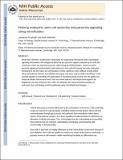Probing Embryonic Stem Cell Autocrine and Paracrine Signaling Using Microfluidics
Author(s)
Voldman, Joel; Przybyla, Laralynne M.
DownloadVoldman_Probing embryonic.pdf (1.450Mb)
OPEN_ACCESS_POLICY
Open Access Policy
Creative Commons Attribution-Noncommercial-Share Alike
Terms of use
Metadata
Show full item recordAbstract
Although stem cell fate is traditionally manipulated by exogenously altering the cells' extracellular signaling environment, the endogenous autocrine and paracrine signals produced by the cells also contribute to their two essential processes: self-renewal and differentiation. Autocrine and/or paracrine signals are fundamental to both embryonic stem cell self-renewal and early embryonic development, but the nature and contributions of these signals are often difficult to fully define using conventional methods. Microfluidic techniques have been used to explore the effects of cell-secreted signals by controlling cell organization or by providing precise control over the spatial and temporal cellular microenvironment. Here we review how such techniques have begun to be adapted for use with embryonic stem cells, and we illustrate how many remaining questions in embryonic stem cell biology could be addressed using microfluidic technologies.
Date issued
2012-04Department
Massachusetts Institute of Technology. Department of Biology; Massachusetts Institute of Technology. Department of Electrical Engineering and Computer ScienceJournal
Annual Review of Analytical Chemistry
Publisher
Annual Reviews
Citation
Przybyla, Laralynne, and Joel Voldman. “Probing Embryonic Stem Cell Autocrine and Paracrine Signaling Using Microfluidics.” Annual Review of Analytical Chemistry 5, no. 1 (July 19, 2012): 293–315.
Version: Author's final manuscript
ISSN
1936-1327
1936-1335